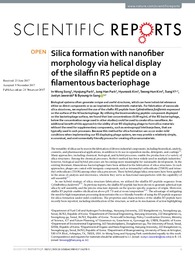
ATTENTION: The works hosted here are being migrated to a new repository that will consolidate resources, improve discoverability, and better show UTA's research impact on the global community. We will update authors as the migration progresses. Please see MavMatrix for more information.
Show simple item record
| dc.contributor.author | Song, In-Wong | |
| dc.contributor.author | Park, Hyojung | |
| dc.contributor.author | Park, Jung Han | |
| dc.contributor.author | Kim, Hyunook | |
| dc.contributor.author | Kim, Seong Hun | |
| dc.contributor.author | Jaworski, Justyn | |
| dc.contributor.author | Sang, Byoung-In | |
| dc.contributor.author | Yi, Sung | |
| dc.date.accessioned | 2018-05-25T22:42:51Z | |
| dc.date.available | 2018-05-25T22:42:51Z | |
| dc.date.issued | 24 November 2017 | |
| dc.identifier.citation | Published in Scientific Reports 7:16212, 1-7, 2017 | en_US |
| dc.identifier.uri | http://hdl.handle.net/10106/27344 | |
| dc.description.abstract | Biological systems often generate unique and useful structures, which can have industrial relevance either as direct components or as an inspiration for biomimetic materials. For fabrication of nanoscale silica structures, we explored the use of the silaffin R5 peptide from Cylindrotheca fusiformis expressed on the surface of the fd bacteriophage. By utilizing the biomineralizing peptide component displayed on the bacteriophage surface, we found that low concentrations (0.09 mg/mL of the R5 bacteriophage, below the concentration range used in other studies) could be used to create silica nanofibers. An additional benefit of this approach is the ability of our R5-displaying phage to form silica materials without the need for supplementary components, such as aminopropyl triethoxysilane, that are
typically used in such processes. Because this method for silica formation can occur under mild conditions when implementing our R5 displaying phage system, we may provide a relatively simple, economical, and environmentally friendly process for creating silica nanomaterials. | en_US |
| dc.description.sponsorship | This work was supported by the Korea CCS R&D Center (Korea CCS2020 Project) grant funded by the Korea government (Ministry of Science, ICT & Future Planning) in 2017 (KCRC-2014M1A8A1049296) and by Basic Science Research Program through the National Research Foundation of Korea (NRF) funded by the Ministry of Education (NRF-2016R1A6A1A03013422). H. Kim was financially supported by Korea Environmental Industry & Technology Institute (Project No: 2015001790002). | en_US |
| dc.language.iso | en_US | en_US |
| dc.publisher | Nature | en_US |
| dc.rights | Attribution 4.0 United States | * |
| dc.rights.uri | http://creativecommons.org/licenses/by/4.0/us/ | * |
| dc.subject | Silica nanomaterials | en_US |
| dc.subject | Cylindrotheca fusiformis | en_US |
| dc.subject | R5 displaying phage system | en_US |
| dc.title | Silica formation with nanofiber morphology via helical display of the silaffin R5 peptide on a filamentous bacteriophage | en_US |
| dc.type | Article | en_US |
| dc.publisher.department | Department of Bioengineering, The University of Texas Arlington | en_US |
| dc.identifier.externalLinkDescription | The original publication is available at Article DOI | en_US |
| dc.identifier.doi | DOI:10.1038/s41598-017-16278-5 | |
Files in this item
- Name:
- s41598-017-13320-4.pdf
- Size:
- 1.254Mb
- Format:
- PDF
- Description:
- PDF
- Name:
- license_rdf
- Size:
- 1.337Kb
- Format:
- application/rdf+xml
This item appears in the following Collection(s)
Show simple item record
Except where otherwise noted, this item's license is described as Attribution 4.0 United States



